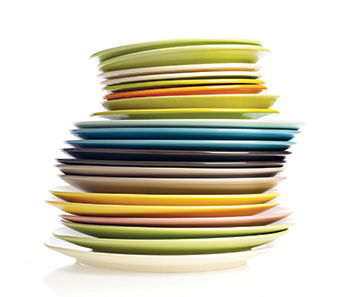Commercial dinnerware includes bowls, plates, platters, cups and mugs, in addition to accessories, such as creamers, salt and pepper shakers, and other ancillary items used on the table.
 The type of restaurant and menu will impact the type of dinnerware the operation requires. Other considerations include the average cost of menu items and average check size, demographics, volume and whether the restaurant offers catering, special-event, holiday or brunch services.
The type of restaurant and menu will impact the type of dinnerware the operation requires. Other considerations include the average cost of menu items and average check size, demographics, volume and whether the restaurant offers catering, special-event, holiday or brunch services.
It’s crucial to order enough dinnerware to serve the maximum number of customers and still have enough in stock when inevitable emergencies arise.
Operators can choose from a variety of dinnerware materials. Some types are vitrified, which means the material has less than 0.3 percent water absorption and is fired at temperatures greater than 2,300 degrees F. Vitrified materials are stronger and harder, with less moisture, odor and bacterial absorption.
Bone china consists of at least 30 percent to 50 percent bone ash, feldspar and kaolin. Calcium phosphate reacts with silica to develop this glassy, translucent material. Well known for its high levels of whiteness, chip resistance and mechanical strength, this material is fully vitrified (converted to impermeable glass through heat).
Porcelain is a ceramic material made by heating raw materials, including clay, in the form of kaolin, feldspar and quartz until it is vitrified. It is often, but not always, fired twice. The bisque material is first fired at approximately 1,652 degrees F and then, when glazed, fired a second time at approximately 2,516 degrees F.
Stoneware starts as primarily a ball of clay that includes oxides from elements such as iron, potassium, magnesium and sodium. The material is usually fired once at temperatures around 2,156 degrees F and is semivitrified, meaning it requires a glaze to be impermeable.
Often referred to as baked earth, terra-cotta is fired clay that contains high amounts of iron, giving it a reddish brown color. The fully vitrified bisque material is first fired at approximately 1,562 degrees F and then, when glazed, fired a second time at approximately 2,552 degrees F.
Operators can choose from various rim types. Narrow-rim plates are commonly used for high-volume operations, such as fast-casual restaurants and large banquet facilities. Dinnerware with a narrow rim takes up less space on a table than wide-rim plates. Wide-rim or rolled-edge dinnerware takes up more table space than narrow rim but offers more room for decoration along the rim. Fine-dining restaurants are more likely to use wide-rim dinnerware for creative presentations. Mid-rim dinnerware is probably the most versatile shape. It allows flexibility in portion control and can be used effectively in nearly any type of foodservice operation for various menu items. Modern and contemporary, coupe-shape dinnerware has virtually no rim, which provides the most usable surface area. Coupe-shape patterns are popular for buffets and banquet service.
There are three foot types, which refers to the bottom of the dinnerware. A wiped foot runs across a sponge-like material. This type is less costly to produce but is prone to scratching surfaces and transfers metal marks. A polished foot is pressed onto a rotating polishing wheel to create a smooth finish. Although this reduces surface scratching and transferring marks, it is more costly to produce. A fully glazed foot is suspended during the glazing process to produce a smooth and consistent base. It is most effective in resisting surface scratching and transfer marks but is the most costly to manufacture.
Dinnerware also is available with a variety of finishes. Colored glaze replaces traditional clear glaze and is an easy substitute in the manufacturing process. This can be a bit more costly, and chips are more evident. Decals are pre-printed materials that are hand applied to each piece. Although this provides much detail and a choice of colors, the finish is more costly to apply and typically requires skilled factory workers. Hand-painted finishes are the most high-end as these require embellishments applied by a skilled artist. The benefit is a unique, artisanal appearance, but this is the priciest option.











